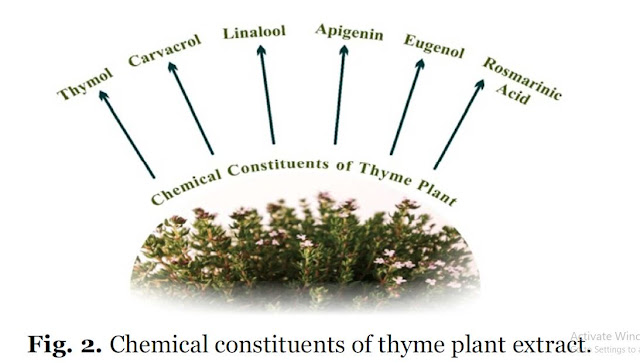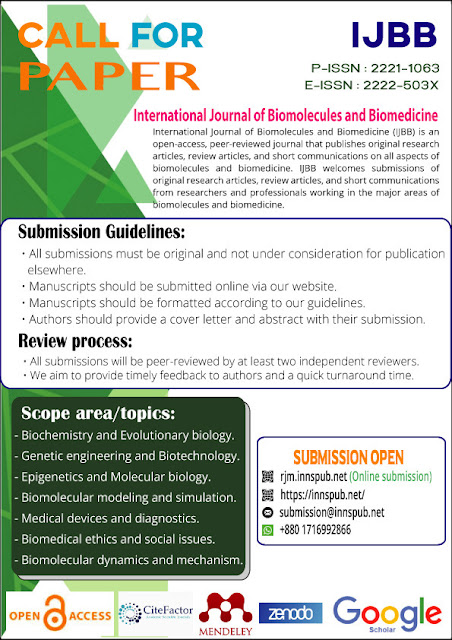Abdus Samee , Rai Muhammad Amir , Asif Ahmad ,
Mudasir Ali , Hira Malik , Ibrahim Jamil , Haya Fatima , and Zunaira Zahoor from the different institute of the pakistan wrote a
review article about Thyme: Exploring Health Benefits for a Better
Lifestyle, entitled," A review on health effects of Thyme (Thymus vulgaris) on
human lifestyle" This research paper published by the International
Journal of Biomolecules and Biomedicine| IJBB an open access scholarly research journal on
Biomedicine, under the affiliation of the International Network For Natural Sciences| INNSpub an open access multidisciplinary research journal publisher.
Abstract
Thyme is a perennial aromatic herbaceous plant for medicinal, culinary, and for ornamental purposes. Thymus vulgaris is the most prevalent species. Thyme is a member of the genus, Thymus, of the mint family (Lamiaceae). Thyme leaves are one of the richest sources of metallic elements, iron, calcium, manganese, metallic element, and antioxidants. Phenols are the main synthetic resin element that is primarily blamed for antioxidant activity. The oil of thyme, the oil of Thymus vulgaris (Thymus vulgaris), contains 20-50% thymol, thymol is one of all naturally occurring categories of compounds referred to as biocides, substances that will destroy harmful organisms. Prior to the introduction of modern antibiotics, thyme oil was used to treat bandages. Thyme has chemical constituents like Thymol, carvacrol, linalool, apigenin, eugenol, and Rosmarinic acid has antiseptic, antibacterial, antifungal, antimicrobial, anti-inflammatory, antithrombotic, antiallergic, antimutant, antioxidative properties. Thyme is packed with antioxidants, vitamin C, and a decent supply of vitamin A. Another health advantage of thyme is that it also has a decent supply of copper, fiber, iron, and metallic element. Traditionally Thymus linearis Benth is used for the treatment of assorted diseases as well as high blood pressure. Thyme extract supplementation magnified endurance exercise tolerance in intact animals. Thyme also has a significant antithrombotic effect.
Read more: Nanotech for Neurological Health: Nasal GelInnovations | InformativeBD
Introduction
Thymus vulgaris L.
(Thyme) is an aromatic small perennial woody plant belonging to the
Lamiaceae family, used for medicinal and spice purposes globally Khosravipour and
Direkv and-Moghadam, 2016.Thyme grows well under dry and sunny
climatic conditions in unshaded areas Dauqan and Abdullah,2017. Thyme is a
perennial bush with greenish-gray aromatic leaves. It originates from Southern
Europe and Mediterranean countries; however, it is now cultivated in temperate
climatic zones throughout theworld Singletary, 2016.
Among medicinal plants,
thyme stands out as a well known medicinal shrub with its high content
in interesting natural compounds and with its various applications in the
traditional medicine Al-Shahraniet al., 2017. Thymus vulgaris L., a member of
the Thymus genus, is the focus of this review, which also covers its biological
characteristics, nutrients, and bioactive substances. It also discusses how this
plan tis used in several industries, including as the food, cosmetic, and
medicinal ones. This study also discusses the most recent clinical
investigations on Thymus vulgaris in order to provide readers with a current
picture of the possibilities of this fragrant plant. The uniqueness of this work
rests on presenting a comprehensive grasp of the most significant potential uses
for T. vulgaris, their potential drawbacks, and the requirement for additional
research studies. Due to their accessibility and affordability, plant-based
medications, sometimes known as "herbal medicines," conventional
therapies, and traditional practitioners, provide the primary or only form of
healthcare for many millions of people, particularly in developing nations
Hosseinzadeh et al., 2015.
Nowadays, the demand
for functional food ingredients that will impart health advantages apart from
basic nutrition is now on verge of rising. Thyme contains of several flavonoids,
and synthetic resin antioxidants like carotenoid, lutein, apigenin,
and naringenin. Thyme is a rich source of minerals and vitamins (beta carotene,
B-complex, vitamins A, K, E, and C, and folic acid,) that are essential for
optimum health. Thyme leaves are one of the richest sources of manganese, iron,
calcium, and antioxidants. Phenols are the major bioactive compounds which
exhibit potent antioxidative activity Dauqan and Abdullah,2017. Thyme has been
reported to exhibit pharmacological applications in drug development, especially
in the preparation of antifungal medicinal formulations Khosravipour and
Direkv and-Moghadam, 2016. Thymol is one of the chief bioactive compounds of
thyme acting as biocides to cause the destruction of harmful microorganisms.
Hence, it might be inferred that thymol will be helpful in mitigating the
microbial resistance common medications like antibiotics Zhang et al., 2018.
Thymus vulgaris was the
subject of a thorough bibliographic search for this review, which focused on both
its nutrients and bio-actives. The description, distribution, and cultivation of
plants as well as their functions in traditional medicine were
covered. Biochemical processes, medical research, potential applications, and
potential restrictions all received special consideration. The diet lifestyle
and disease prevention are emerging topic in these days therefore the current
situation for Thymus vulgaris plant to be investigated and urge the researcher
to conduct trials on effects of T. vulgaris
Plant HistoryThyme has historically been used to performcosmetic, culinary, and for medicinal functions. EarlySumerian and Egyptian cultures used thyme forhealth purposes and for the preservation of deceasedbodies. Roman people burned thyme to discouragedangerous animals and the aroma of cheese andalcoholic beverages. Ancient Romans bathed withthyme because it was thought to give vigor. Thecommon name for thyme is also derived from theGreek word thymon, which signifies bravery or a cureBasch, et al., 2004.
Reference
Akhtar MS, Jabeen Q,
Khan HU, Maheen S, Karim S, Rasool S, Khan W. 2014. Pharmacological
evaluation of antihypertensive effect of aerial parts of Thymus
linearis Benth. Acta Poloniae Pharmaceutica 71(4), 677-682.
Al-Shahrani MH, Mahfoud
M, Anvarbatcha R, Athar MT, Al-Asmari A. 2017. Evaluation of antifungal
activity and cytotoxicity of Thymus vulgaris essential
oil. Pharmacognosy Communications 7(1), 34-40.
Basch E, Ulbricht C,
Hammerness P, Bevins A, Sollars D. 2004. Thyme (Thymus vulgaris L.),
thymol. Journal of Herbal Pharmacotherapy 4(1), 49-67.
Craig WJ. 1999.
Health-promoting properties of common herbs. The American Journal of Clinical
Nutrition 70(3), 491-499.
Dauqan EM, Abdullah A. 2017.
Medicinal and functional values of thyme (Thymus vulgaris L.) herb.
Journal of Applied Biology and Biotechnology 5(2), 0-2.
Gumus R, Ercan NAZLI,
Imik H. 2017. The effect of thyme essential oil (Thymus vulgaris) added to
quail diets on performance, some blood parameters, and the antioxidative
metabolism of the serum and liver tissues. Brazilian Journal of Poultry
Science 19, 297-304.
Hosseinzadeh S,
Jafarikukhdan A, Hosseini A, Armand R. 2015. The application of medicinal
plants in traditional and modern medicine: A review of Thymus vulgaris.
International Journal of Clinical Medicine 6(09), 635.
Javed H, Erum S,
Tabassum S, Ameen F. 2013. An overview on medicinal importance of Thymus
vulgaris. Journal of Asian Scientific Research 3(10), 974-982.
Khani M, Motamedi P,
Dehkhoda MR, Dabagh Nikukheslat S, Karimi P. 2017. Effect of thyme extract
supplementation on lipid peroxidation, antioxidant capacity, PGC-1α content and
endurance exercise performance in rats. Journal of the International
Society of Sports Nutrition 14(1), 1-8.
Khosravipour B,
Direkvand-Moghadam F. 2017. The development of Thyme plant as a medicinal
herb: A review article. Advanced Herbal Medicine 3(2), 47-53.
Mihailovic-Stanojevic
N, Belščak-Cvitanović A, Grujić-Milanović J, Ivanov M, Jovović D, Bugarski D,
Miloradović Z. 2013. Antioxidant and antihypertensive activity of extract
from Thymus serpyllum L. in experimental hypertension. Plant
Foods for Human Nutrition 68(3), 235-240.
Mihailovic-Stanojevic
N, Belščak-Cvitanović A, Grujić-Milanović J, Ivanov M, Jovović D, Bugarski D,
Miloradović Z. 2013. Antioxidant and antihypertensive activity of extract
from Thymus serpyllum L. in experimental hypertension. Plant
Foods for Human Nutrition 68(3), 235-240.
Miloradovic Z, Bugarski
B, Komes D, Milanovic JG, Ivanov M, Jovovic DJ, Mihailovic-Stanojevic N. 2010.
Thyme extract improves blood pressure and oxidative stress in spontaneously
hypertensive rats. Journal of Hypertension 28, e496.
Prasanth Reddy V, Ravi
Vital K, Varsha PV, Satyam S. 2014. Review on Thymus vulgaris traditional
uses and pharmacological properties. Medicinal & Aromatic Plants 3(164), 2167-0412.
Rašković A, Pavlović N,
Kvrgić M, Sudji J, Mitić G, Čapo I, Mikov M. 2015. Effects of
pharmaceutical formulations containing thyme on carbon tetrachloride-induced
liver injury in rats. BMC Complementary and Alternative Medicine 15(1), 1-11.
Singletary K. 2016.
Thyme: history, applications, and overview of potential health benefits.
Nutrition Today 51(1), 40-49.
Yamamoto J, Yamada K,
Naemura A, Yamashita T, Arai R. 2005. Testing various herbs for
antithrombotic effect. Nutrition 21(5), 580-587.
Zhang Z, Zhang S, Su R,
Xiong D, Feng W, Chen J. 2019. Controlled release mechanism and
antibacterial effect of layer‐by‐layer self‐assembly thyme oil microcapsule.
Journal of Food Science 84(6), 1427-1438.
Source: A review on health effects of Thyme (Thymusvulgaris) on human lifestyle











%20in%20full.JPG)


0 comments:
Post a Comment